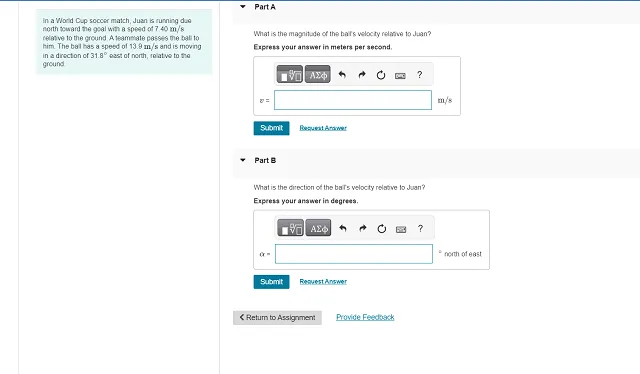Question
In a World Cup soccer match, Juan is running due north toward the goal with a speed of 7.40 m/s relative to the ground. A teammate passes the ball to him. The ball has a speed of 13.9 m/s and is moving in a direction of 31.8∘ east of north, relative to the ground. What is the magnitude of the ball’s velocity relative to Juan? Express your answer in meters per second. Part B What is the direction of the ball’s velocity relative to Juan? Express your answer in degrees.
Answer
Step 1

Step 2
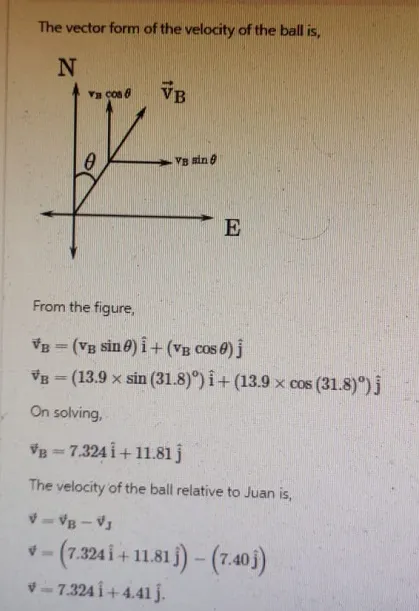
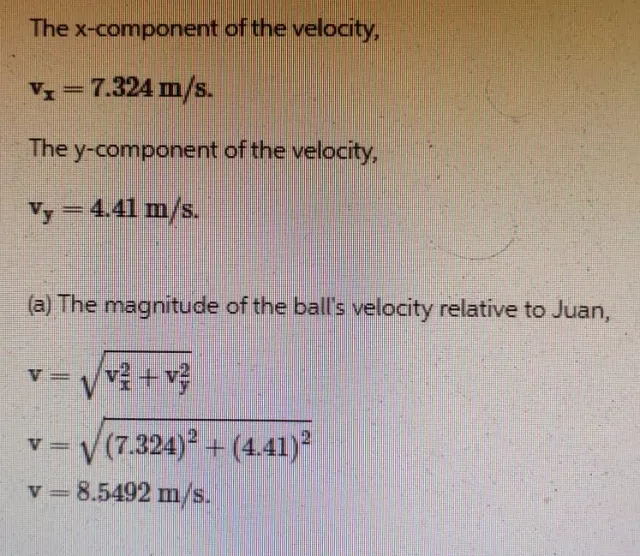
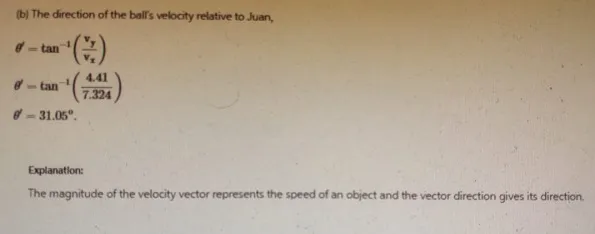
Answer

Table of Contents
World Cup Soccer Dynamics: Calculating Ball Velocity Relative to a Player
Introduction
Soccer, known globally as the beautiful game, is a sport rich with strategic complexity and physical prowess. Beyond the visible skills on the field lies an intricate web of physics principles that govern every pass, shot, and save. One such principle is relative velocity, which is crucial when analyzing the movement of the ball in relation to a player in motion. Understanding relative velocity helps us analyze the ball’s movement from the perspective of different players.
In the heat of a World Cup match, players must make split-second decisions, relying on their intuitive grasp of motion and velocity. This intuitive understanding can be further enhanced through the principles of physics. Calculating the ball’s velocity relative to a player provides insights into how fast the ball is approaching and its direction, which are critical for making precise plays. These calculations are not only fascinating from a scientific standpoint but also immensely practical for improving performance on the field.
Moreover, the study of relative velocity in soccer offers a perfect example of how physics principles apply to real-world situations. By breaking down the components of motion and utilizing vector subtraction, we can transform the way we perceive and engage with the game. This approach not only benefits players and coaches but also enriches the experience for fans who appreciate the underlying mechanics of the sport.
In this article, we will explore how to calculate the ball’s velocity relative to a moving player using a real-world example from a World Cup soccer match. This understanding not only enhances our appreciation of the game but also deepens our grasp of fundamental physics concepts. Through detailed explanations and step-by-step calculations, we aim to provide a comprehensive guide to mastering the dynamics of soccer.
Understanding Relative Velocity in Soccer
Relative velocity refers to the velocity of one object as observed from another moving object. In soccer, this concept is particularly relevant when players pass the ball to each other while in motion. Calculating the ball’s velocity relative to a player helps in understanding the dynamics of play, such as how fast the ball approaches the player and in what direction.
The Scenario
Consider a situation in a World Cup match where Juan is running due north towards the goal with a speed of 7.40 m/s relative to the ground. His teammate passes the ball to him with a speed of 13.9 m/s, and the ball is moving in a direction 31.8° east of north relative to the ground. Our task is to determine the magnitude and direction of the ball’s velocity relative to Juan.
Breaking Down the Problem
To find the ball’s velocity relative to Juan, we need to perform vector subtraction. Here’s how to break down the problem:
- Determine the Components of Juan’s Velocity

- Determine the Components of the Ball’s Velocity

- Calculate the Relative Velocity Vector
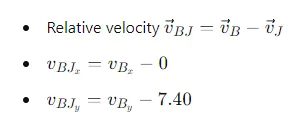
Performing the Calculations
- Calculate the Components of the Ball’s Velocity

- Calculate the Components of the Relative Velocity

- Calculate the Magnitude of the Relative Velocity

- Calculate the Direction of the Relative Velocity

Conclusion
Understanding the relative velocity of a soccer ball during a match is essential for players and coaches to make informed decisions and optimize performance. By breaking down the motion into components and using vector subtraction, we can accurately calculate the ball’s speed and direction relative to a moving player. This knowledge not only enhances our understanding of the game but also demonstrates the application of fundamental physics in sports. Whether you are a student, a soccer enthusiast, or a professional player, mastering these calculations provides valuable insights into the dynamics of soccer.

